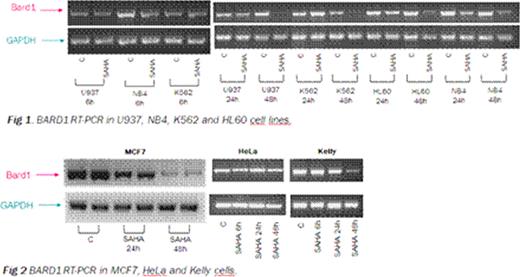Abstract
Abstract 4642
BARD1 (BRCA1-associated RING domain protein 1) was first described as a BRCA1 partner and tumour suppressor protein, muted in most cases of breast and ovarian cancer. BARD1 functions are BRCA1-dependent, requiring formation of a stable heterodimer through interaction of the RING finger domains. BRCA1-independent functions for BARD1 have recently been described, making it an interesting and important molecule for study.
BARD1 is expressed in almost all human tissues, including haematological cells, testis and breast tissue, but it is over-expressed in leukaemias, sarcomas and testis cancer, implicating BARD1 in development of cancer. Different BARD1 isoforms are up-regulated in breast, ovarian and uterine cancers but markedly down-regulated or absent in healthy tissues. Therefore, the presence of these isoforms might be a risk factor or causal event in the cancer pathogenesis.
We investigated the role of BARD1 isoforms in leukaemia, through the study of the epigenetic mechanisms involved in regulation of its expression and function. As such, we determined the expression of a specific BARD1 isoform in different human leukaemia cell lines the effects of the histone deacetylase inhibitor SAHA (suberoylanilide hydroxamic acid, Vorinostat) of expression of BARD1.
Four human leukaemia cell lines (U937, NB4, K562 and HL60) express the BARD1 isoform of interest. Treatment of these cell lines with SAHA at 5 μ M resulted in decreased expression of this isoform (Fig. 1 ).
Decreased expression of BARD1 by SAHA was also observed in in human breast cancer MCF7 cells, the usual model for BARD1 experiments and in the human neuroblastoma cell line Kelly (Fig. 2), but not in HeLa cells or an human epithelial carcinoma cell line (Fig. 2 ). The reduced expression of BARD1 was attributed to the action of 2 specific micro-RNAs (miRNAs), that directly bind its 3′untranslated region (UTR). SAHA-induced expression of miR-19a and miR-19b in primary human leukemia cells as demonstrated using miRNA microarray expression analysis and confirmed by Real-Time PCR (Fig. 3 ). These 2 miRNA were up-regulated after SAHA stimulation in human leukaemia cells. BARD1 is the predicted target for miR-19a and miR-19b based on miRBase database analyses. Transient transfection in NB4 cells with mimic miR-19a and mimic miR-19b confirmed expression of these miRNAs was associated with BARD1 down-regulation (Fig. 4 5.). The BARD1 3′UTR was cloned into a pGL3 vector with a downstream the luciferase gene reporting gene (Fig. 6). The plasmid was co-transfected in HeLa cells with each mimic miRNA and a luciferase assay was performed. We demonstrate that expression of miR-19a and miR-19b can directly bind BARD1 3′UTR, reducing luciferase activity in this system (Fig. 7), thereby confirming that BARD1 is a target of these miRNAs.
These findings support our hypothesis that BARD1 is a promising target in leukemia and should be further investigated for its diagnostic and prognostic features.
No relevant conflicts of interest to declare.
Author notes
Asterisk with author names denotes non-ASH members.




This feature is available to Subscribers Only
Sign In or Create an Account Close Modal